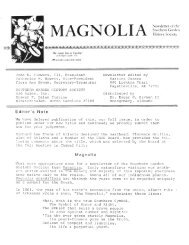Vol. XII, no. 2, 3 & 4 - Southern Garden History Society
Vol. XII, no. 2, 3 & 4 - Southern Garden History Society
Vol. XII, no. 2, 3 & 4 - Southern Garden History Society
Create successful ePaper yourself
Turn your PDF publications into a flip-book with our unique Google optimized e-Paper software.
x opaca)-<br />
<strong>Southern</strong> <strong>Garden</strong>s of th e<br />
1850s . . . continued from page 2<br />
spring and fall .<br />
The Varnish tree (Stericlua platynifolia) 3 (sic) is so<br />
called from its beautiful glossy bark, and large rich<br />
colored leaves, which seem all to have been recently<br />
coated with green varnish. It is, altogether, a pretty an d<br />
desirable ornamental shade tree .<br />
The Croton tree 4, and Everblooming China5 are<br />
both pretty trees, though, in a severe winter, the ends<br />
of the branches are sometimes killed by the frost.<br />
The Acacia julihrissin6 , or flowering Acacia ,<br />
though by <strong>no</strong> means rare, is yet too-showy, with it s<br />
myriads of pink and yellow flowers, to be omitted i n<br />
pleasure grounds, or even smal l<br />
yards .<br />
Several of the Maples are native<br />
here, and form, as elsewhere, mos t<br />
beautiful trees. Perhaps the best of<br />
these is the Scarlet Maple, so showy<br />
in the spring with its bright scarlet<br />
blossoms. The ash-leaved Mapl e<br />
(Segundo) or Box Elder, can<strong>no</strong>t be<br />
excelled as a shade tree in any<br />
country, where it has room to grow<br />
and spread. Several of the European<br />
Maples do well here, and desirable<br />
trees .<br />
The Chestnut is one of th e<br />
many stately trees of the forest, an d<br />
desirable <strong>no</strong>t only as a lawn tree ,<br />
but for its fruit . The large fruited<br />
Spanish is the finest' .<br />
Our Great <strong>Southern</strong> Cypres s<br />
Taxodium) should never h e<br />
omitted, where the soil is rich an d<br />
moist. The chief cause of its rarity<br />
in lawns, etc ., is the difficulty o f<br />
transplanting young trees from the<br />
swamp, to the dry upland of our hills . With tree s<br />
grown on dry land from seed, there is <strong>no</strong> suc h<br />
difficulty .<br />
The graceful weeping willow, though so easil y<br />
grow, is comparatively rare . The curled-leaved variety8<br />
being quite as weeping in its habits as the other, is very<br />
curious. Each leaf is curled up like a cork-screw .<br />
The Ginkgo (Salisharid)9 or Maiden-hair tree is pretty,<br />
and quite ornamental. The leaves are very curious .<br />
The double-flowering Peach is one of the mos t<br />
showy of trees, forming early in the spring, a mass o f<br />
wreaths of rich and extremely double, rose-like<br />
blossoms .<br />
Where there is room for a few large and wide -<br />
spreading trees, the Peccan (sic) should <strong>no</strong>t be<br />
Harper's Weekly, 1887, illustration<br />
showing the street trees planted dow n<br />
Dexta Avenue .<br />
overlooked. They afford a fine shade, and come<br />
into bearing in eight or ten years .<br />
We k<strong>no</strong>w of one gentleman in western<br />
Texas, who has some 15 or 20 varieties of thi s<br />
delicious nut, which he has succeeded in multi -<br />
plying by grafting . Two years ago, he sent the writer a<br />
quantity of nuts from each of 8 or 10 of the finest of hi s<br />
selections. These were planted and have produced a<br />
fine lot of trees ; the trees from each variety of nut show<br />
a wonderful family likeness, in foliage, habit of growth ,<br />
& c; whilst there is a marked difference between th e<br />
lots. They have been all twice transplanted, and rootpruned<br />
each time ; thus in a great measure obviating<br />
the difficulty in transplanting when the trees are older .<br />
The Mountain Ash, or Rowan Tree, dear to every<br />
Scotchman's boyish recollections, we have succeede d<br />
in acclimating . It is a beautiful tree .<br />
The large-leaved Mag<strong>no</strong>li a<br />
(M. macrophylla) from that sam e<br />
difficulty of transplanting fro m<br />
the woods, is quite rare in ou r<br />
gardens; where its magnificen t<br />
foliage and immensely large and<br />
showy flowers fully entitle it to a<br />
first place . When grown from see d<br />
in the nursery-row, there is n o<br />
difficulty in removing it .<br />
Of evergreen shade trees, th e<br />
Mag<strong>no</strong>lia grandiflora stands first .<br />
Like its companion the Holly. it i s<br />
<strong>no</strong>t easily removed from the woods .<br />
When quite young this may be<br />
effected, by lifting with a ball of<br />
earth around the roots, in the spring ,<br />
and cutting off the leaves, bu t<br />
leaving the leaf-stalks. They well<br />
deserve that every available mean s<br />
should he used to secure both – the<br />
Mag<strong>no</strong>lia and the Holly (Ile<br />
whenever shade and ornament are<br />
sought for. During the first three o r<br />
four years from seed, their growth is quite slow; bu t<br />
afterwards they push up rapidly, and soon for m<br />
handsome trees .<br />
There is a<strong>no</strong>ther Holly, a native to the South, and<br />
an evergreen, that is very generally overlooked . It i s<br />
more commonly planted about Mobile than anywher e<br />
else. This is Ilex Vomit-aria (sic). The growth is slender ,<br />
leaves small and numerous, and in winter the plant i s<br />
covered with bright scarlet berries .<br />
Of the various Coniferae, it is rare to find a plant i n<br />
a lawn in all this region; unless perhaps, an occasiona l<br />
Long-leaved or Old-field Piney – both most <strong>no</strong>ble an d<br />
beautiful trees, and <strong>no</strong>t planted one for a thousand tha t<br />
should be. There are many other Pines, from all parts<br />
of the world, <strong>no</strong>w to be found in nurseries, and al l<br />
continued on page 4 . . .<br />
3
















